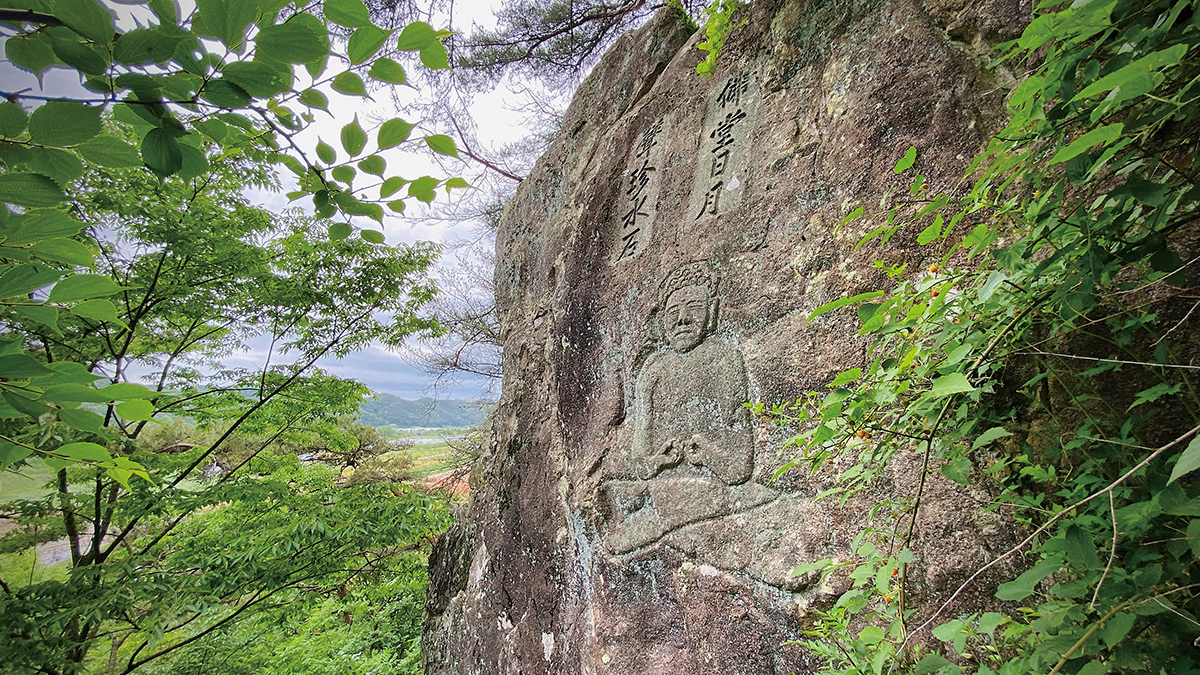Finding Buddha and Goldmines in Yongjin-san
By Isaiah Winters
Yongjin-san has hidden treasures inside and out. Located on Gwangju’s northwestern periphery, it gets very few visitors despite being the city’s sharpest peak and home to at least two little-known abandoned goldmines, plus an even lesser-known Buddha carving. One of the goldmines was featured in this column four years ago and was originally made known to me by my friend Warren Parsons. Being the local oracle of all things obscure in Korea that he is, Warren recently tipped me off to the whereabouts of a second goldmine with a Buddha carving nearby. So, in this June edition of “Lost,” we’ll return to Yongjin-san to see what more this underrated mountain yields.
When I arrived at the trailhead, which was located along a sleepy tributary of the Hwangnyong River, I immediately got distracted by an abandoned factory nearby and so darted for that shiny (but actually crumbling and leprotic) object. Though mostly empty, the factory housed giant metal drums of some sort of chemical imported from Slovakia. Each label had been meticulously scratched off where the chemical name should be, suggesting they were full of some godawful sludge. Finding so much unmanaged waste in the watershed of a major river was disconcerting to say the least.
Just beyond the abandoned factory was yet another shiny object: Yongjin Temple. Webbed with colorful lanterns in anticipation of Buddha’s birthday, I couldn’t help but give in to this next distraction and so wandered even further from my intended trailhead. Though small and wedged beside an ugly highway overpass, the temple was cozy and freshly painted, suggesting recent renovations. The one downside was that in the run-up to Buddha’s birthday, the monks felt the need to hang a crooked, tacky event banner across the most beautifully detailed eaves of the temple entrance, cheapening the site’s serenity.
Almost committed to distractions at this point, I found a hiking trail leading from the rear of the temple and decided to see where it went. The direction it headed suggested it would loop me back to the original trailhead I was supposed to start from, so I took that as a good omen. Along the trail was a pair of pavilions, one serving to house an active well and the other serving as a viewpoint for passing hikers. Hearing water trickle beneath the former, I lifted one of the boards covering the well and was surprised to see a nest of crickets clinging to the bottom. They scurried like spiders to avoid the light, and I recoiled in disgust back to the trail.
Halfway down the trail, the Buddha carving emerged from a break in the canopy. Carved roughly in low relief upon the rockface, the late-Joseon Era Buddha sat in a lotus position with its hands together. The most intricate details were on the Buddha’s head, with an urna bump between the eyes and an ushnisha head bulge above that, both of which symbolize some combination of wisdom, enlightenment, or omniscience, depending on the source you consult. The placard beneath the Buddha was scant on details and mainly described what your eyes could already see, so somewhat disappointingly, I had to find these details myself online.
While hiking down past the Buddha carving, I began to worry that I’d lost my knack for close observation and entirely missed the abandoned goldmine. I hadn’t in fact missed it, as the mine was situated right at the beginning of the trailhead from where I should’ve begun. This mine’s opening looked quite a bit different from that of its sister mine further up the mountain, as someone had bricked it shut and added a door, which someone else later busted down. One similarity was that both were drift mines, meaning the tunnels had been driven horizontally into the mountainside following an ore stream at a gradual slope. This mine had a bit more headroom than the other and so appeared easier to explore, but the tradeoff was that, given its close proximity to a road, some idiots just couldn’t resist using it as a trash dump.
As inviting as moldy, bat-festooned tunnels into the dank, black innards of mountains can be, I draw a clear line at entering mines alone. I had friends to enter mines with me at Romania’s Roșia Montană and a personal guide to lead me through the catacombs beneath Odessa in Ukraine. But until I find someone in Gwangju to share the fear with, I’m happy to let these mines remain a mystery.
The Author
Born and raised in Chino, California, Isaiah Winters is a pixel-stained wretch who loves writing about Gwangju and Honam, warts and all. He’s grateful to have written for the Gwangju News for over six years. More of his unique finds can be seen on Instagram @d.p.r.kwangju and YouTube at Lost in Honam.





